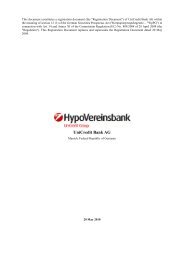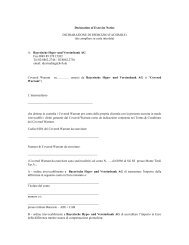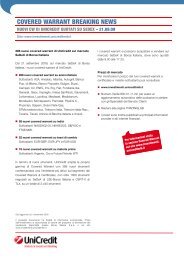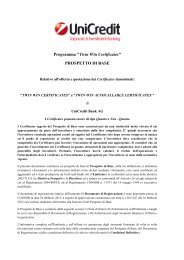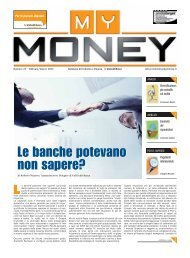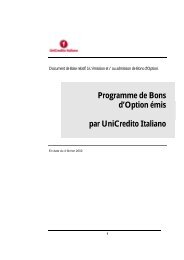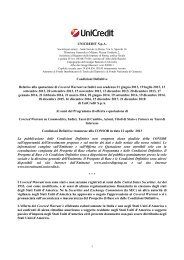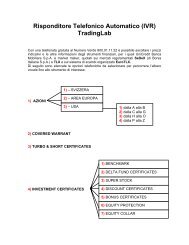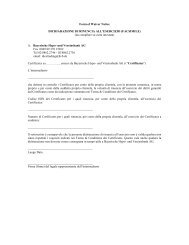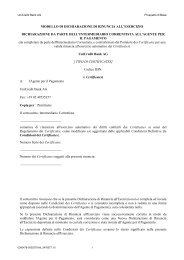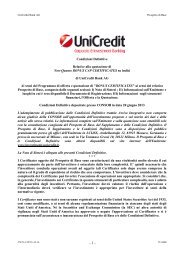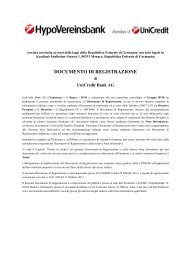HVB DIP 2006-Title Summaryv13.DOC - UniCredit
HVB DIP 2006-Title Summaryv13.DOC - UniCredit
HVB DIP 2006-Title Summaryv13.DOC - UniCredit
Create successful ePaper yourself
Turn your PDF publications into a flip-book with our unique Google optimized e-Paper software.
12<br />
on their procedures for transfer, payment and communication with the Issuer.<br />
Prospective investors should be aware that the payment of principal and/or interest, other than fixed rate interest,<br />
can be linked to different factors such as indices, equity assets, commodities and other assets, or can be limited<br />
on the amounts received by the Issuer from a third party. Therefore, the risk of default with respect to such interest<br />
payment depends on the specific risks associated with the applicable type of reference asset.<br />
Prospective investors in the Instruments should be aware that an investment in the Instruments may involve exchange<br />
rate risks and should therefore determine whether an investment in the Instruments is appropriate in their<br />
particular circumstances.<br />
The market value of the Instruments will be affected by the creditworthiness of the Issuer and by a number of<br />
additional factors including, but not limited to, the value of the respective reference assets or the indices and<br />
prospects, market interest and yield rates and the time remaining to the maturity date of the Instruments. The<br />
price at which a Noteholder will be able to sell the Instruments prior to maturity may be at a discount from the<br />
issue price or the purchase price paid by such purchaser. Such discount may be substantial.<br />
The amount of principal and/or interest, if any, payable by the Issuer in respect of Credit Linked Notes might be<br />
substantially less than the purchase price invested by the Noteholder and may even be zero in which case the<br />
Instrumentholder may lose his entire investment.<br />
Risks relating to Bayerische Hypo- und Vereinsbank AG<br />
An investment in the Instruments involves certain risks relating to the Issuer and the relevant Tranche of Instruments.<br />
While all of these risk factors involve contingencies which may or may not occur, potential investors<br />
should be aware that the risks involved with investing in the Instruments may, among other things, (i) affect the<br />
ability of the Issuer to fulfill its obligations under the Instruments issued under the Programme and/or (ii) lead to<br />
a volatility and/or decrease in the market value of the relevant Tranche of Instruments whereby the market value<br />
falls short of the expectations (financial or otherwise) of an investor upon making an investment in such Instruments.<br />
Prospective investors should consider, among other things, the factors described under "Risk Factors" below<br />
which identify certain risks inherent in investing in Instruments issued under the Programme and in regards to<br />
the Issuer.<br />
However, each prospective investor of Instruments must determine, based on its own independent review and<br />
such professional advice as it deems appropriate under the circumstances, that its acquisition of the Instruments<br />
is fully consistent with its (or if it is acquiring the Instruments in a fiduciary capacity, the beneficiary's) financial<br />
needs, objectives and condition, complies and is fully constent with all investment policies, guidelines and<br />
restrictions applicable to it (whether acquiring the Instruments as principal or in a fiduciary capacity) and is a fit,<br />
proper and suitable investment for it (or if it is acquiring the Instruments in a fiduciary capacity, for the beneficiary),<br />
notwithstanding all of the risks inherent in investing in or holding the Instruments.<br />
Risks Related to the Business Combination of the <strong>UniCredit</strong> Group and the <strong>HVB</strong> Group<br />
Unforeseen difficulties in connection with the Business Combination of <strong>UniCredit</strong> Group and <strong>HVB</strong> Group may<br />
have a material adverse effect on <strong>UniCredit</strong> Group’s and <strong>HVB</strong> Group’s business, financial condition and results<br />
of operations.<br />
The business combination will result in the integration of two large banking groups that were previously managed<br />
and operated independently and as competitors. This complex integration poses specific challenges that will<br />
expose the newly formed combined group and <strong>HVB</strong> Group to certain risks, including the following:<br />
• Uncertainties of achieving synergies. Although HypoVereinsbank expects the business combination to<br />
create synergies, the integration of two large banking groups based in different countries, with differing<br />
cultural backgrounds, business cultures, operating languages and compensation structures as well as legal<br />
framework, which are active throughout a large geographical area, presents significant managerial<br />
chal-lenges. There can be no assurance that this integration, and the synergies expected to result from<br />
the inte-gration, will be achieved as rapidly or to the extent currently anticipated.<br />
• Complex harmonization of <strong>UniCredit</strong> Group’s and <strong>HVB</strong> Group’s IT systems. Harmonizing <strong>UniCredit</strong><br />
Group’s and <strong>HVB</strong> Group’s IT systems to create a consistent IT architecture across the combined group<br />
poses specific challenges and risks to <strong>HVB</strong> Group.<br />
• Complex integration of <strong>UniCredit</strong> Group’s and <strong>HVB</strong> Group’s risk management systems. <strong>UniCredit</strong><br />
Group and <strong>HVB</strong> Group currently use different methodologies to measure and manage risks. The integra-tion<br />
of the two risk management systems following the business combination will likely aggravate<br />
the risk of a potential failure or inadequacy of the combined group’s risk management systems, in particular<br />
during the initial integration phase.




